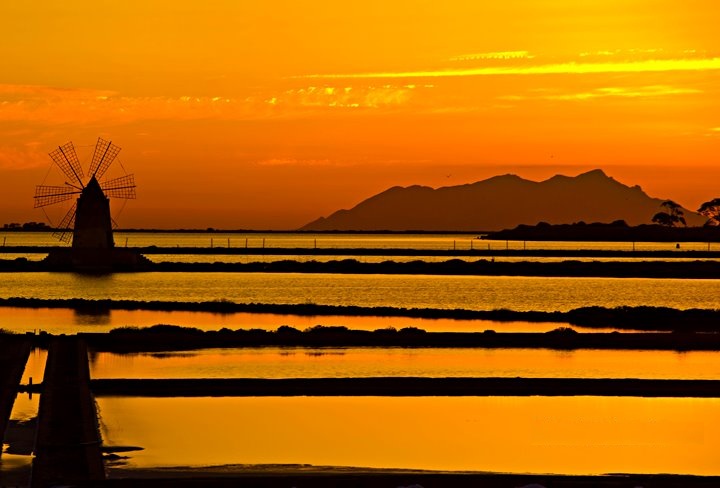It may be hard to imagine, these days, that Sicily was once the cradle of European civilisation. Three super-powers battled for supremacy and Sicily was the centre of it all.
Today, I’ll tell you about the Phoenicians, the earliest super-power and Sicily’s first colonists.
Carthaginians and Phoenicians: the first empire
The Phoenicians were the first super-power, from the narrow strip of coastal land now called Lebanon.
 Fearless sailors and ingenious traders throughout the known world, the Phoenicians invented money, created an alphabetic script for taking inventory, and built the world’s first import-export economy.
Fearless sailors and ingenious traders throughout the known world, the Phoenicians invented money, created an alphabetic script for taking inventory, and built the world’s first import-export economy.
Everyone in the ancient world wanted their red murex shellfish, because wearing clothes in this special colour protected them against the Evil Eye, a terrifying primal force which caused infertility, crop failure and death. Egyptian Pharaohs, Roman Consuls and Greek dictators dared not leave the house without their red clothes on. The name „Phoenician“ comes from the Greek word for red.
This was not all they sold. They also produced fine glass artwork and ceramics, they transported rare food crops, and they sold the best wood in the world for making ships’ masts, from their indigenous Lebanese pines.
Phoenician colonies sprang up all over the Mediterranean. These began as small trading stations, with a warehouse and a few guards who stayed behind to protect the merchandise and trade with the locals. Gradually, they grew into full-scale city-states. Their seminal culture laid the groundwork for much of modern Mediterranean religions, foods, languages, agriculture and art.
Carthage (nowadays called Tunis), benefitted from its central position and eventally became the largest of all the Phoenician city-states. When the Assyrians of modern-day Iraq conquered Phoenicia around 800 B.C., Carthage became the centre of the Phoenician civilisation. Carthage founded colonies of its own, including many in Sicily.
And the evil eye? To this day, some elderly Sicilians sprinkle salt inside their doorways and hide red pouches of lucky charms inside their clothing, to protect temselves from its harmful powers.
How to get the Phoenician feel in Sicily
Have a plate of pasta with lentils, both made from the cereals and lentils the phoenicians loved and brought to Sicily. Garnish it with the sea salt they produced on an industrial scale in Sicily. Don’t forget to wear something RED just to be on the safe side!
Wash it down with wine from the Marsala region, where they established vast vinyards full of grape species they imported from the Middle East.
Then enjoy some fresh figs, a Lebanese crop which the Phoenicians brought over to Sicily and spread throughout their Mediterranean colonies.
Where to see the Phoenicians in modern Sicily
Solunto
Near Santa Flavia, this was originally a major Carthaginian trading post which was taken over by the Greeks then the Romans, who eventually abandoned it for reasons unknown. It is off the beaten track for tourists so you nearly always get this place entirely to yourself, though you just might meet me there from time to time, showing people how to correctly use and socialise upon the 2,500-year-old toilets.
Mozia
This is an island just off the coast of Sicily near Marsala. Its ancient Phoenician city still stands, including a massive shipyard and sacrificial altar. There is a stone road under the sea which the Phoenicians used to transport barrels of wine from the island – where they had established vinyards – to the mainland by horse-drawn cart (in about 3 feet of water): The Sicilians were still using it till the 1950’s.
Marsala
There are salt works at Marsala which were founded by the Phoenicians and are still used to make organic sea salt.






Mozia is one of my favourite ancient sites – there’s something about crossing to a small island that makes it seem even more evocative and romantic. Bit of a zoo in summer, admittedly, but lovely on a quiet spring day, just you, the wildflowers and the little lizards scampering across the tracks.
LikeLiked by 3 people
I thought the Three Super Powers were Wine, Women, and Song?!?
LikeLiked by 3 people
LOL! 😀
LikeLike
Those Phoenicians were pretty crafty-they came up with Trabucchi, the fishing contraptions found on the coast of the Gargano, Abruzzo and Molise.
LikeLiked by 3 people
Wow, I had never heard of those and just looked them up! They look amazing! I think I feel another day-trip coming up soon 🙂
LikeLiked by 1 person
You definitely need to visit a trabucco Casalinga Siciliana! They are amazing. I wrote a post about them a few months ago with photos of the trabucchi del Gargano I’ve visited http://unpodipepe.ca/2015/03/09/i-trabucchi-del-gargano/ Ciao, Cristina
LikeLiked by 1 person
Concerning the Roman senators: They had only a red strip on their toga because the colour was expensive in their days, and colouring the whole toga meant to spend a fortune. The economical spirit of Roman discipline introduced a new fashion we all know from historical movies!
LikeLiked by 1 person
Yes, they had strict laws about how thick the stripe could be, according to importance. The more important and powerful you were, the more you were in danger of the evil eye being cast on you.
It was only victorious generals celebrating triumphal processions who could wear red togas all over, since they were bound to attract massive amounts of envy and hence the evil eye. (Their chariots were also covered in phallic symols and other protections against the evil eye)
Julius Caesar’s habit of wearing his triumphal red toga all the time (later copied by all the emperors) was seen as a sign of his ambition to become absolute ruler with god-like powrs and was one of theithings that stirred up the senators to assassinate him.
LikeLiked by 1 person
I keep thinking how lucky your little guy is to have you as a tutor! You manage to make these things so riveting, V. Also, is that your gorgeous photo of the salt flats? I have got to send you the one of the sunset you asked for. Sorry I’m so behind in my downloads. Great post as always!
LikeLiked by 1 person
No, I must admit that stunning photo is a Wikimedia one.
I stuck all my own salt flats photos on a pen drive, I must try to remember where I put that… erm……hmm…..
I am still waiting for the little lad to start enjoying history as much as I do. Though I did have a good breakthrough on the advice of a friend, who suggested I tell him stories about children in the past which convey all the info in the form of a little boy his age having an adventure.
So far we have had Lug, the neolithic boy who first captured herds of animals and domesticated them;
Baaluca, a Phoenician boy who stowed away on a boat delivering murex to Carthage;
Loukos, a Greek boy who was very good at bull jumping in Ancient Crete.
Next year it wil be all about a Roman boy called Lucus and his Athenian friend called Loukos!!!!!
LikeLiked by 1 person
Brilliant!
LikeLike
Hello, my name is Irina and I must say I really do like your blog!
I am a huge history lover, and unfortunately I was not chosen to go to my school’s Italy trip…Which is awful because one of the stops was at an Etruscan city and a couple of the chosen people (they were in my class) kept saying it was Roman, and I resisted the urge to throw a history book at their head… : )
So while I know that Italy still has a bit of Etruscan cities and towns, I didn’t know that anything was left by the Phoenicians (other than I.P.A) because I thought the Greeks and the Romans did a very good job on getting rid of them lol!
And now I must visit Solunto and Mozia in about four years!
LikeLike
I hope you make it there and have a great time! 🙂
LikeLike
I think your blog is simply awesome, my name is Claude and I am from Lebanon. Its extremely encouraging and makes me so happy that there is people out there who knows the truth and the legacy the Phoenicians left behind that had such an impact on the world especially the meditteanean. I recently had a DNA test which confirmed my phoenician heritage and I am so incredibly proud, we are trying to bring back Aramaic language into mainstream school cirrucalum which has been done already in galille by lebanese ex – pat. Very well done for your knowledge and keep up the good work, Merry Christmas.
LikeLiked by 1 person
Thank you for your very kind comments about my blog!
The project to restore Aramaic in schools sounds like a brilliant project. They did something similar in Wales (where my father is from) when Welsh was spoken by so few families it looked sure to become extinct. By teaching Welsh in schools and making it obligatory for public offices to offer their services in Welsh as well as English, they restored it to being a widely spoken language.
I hope that Lebanese Aramaic can be restored in the same way.
LikeLike